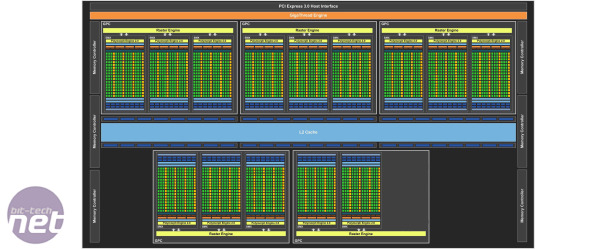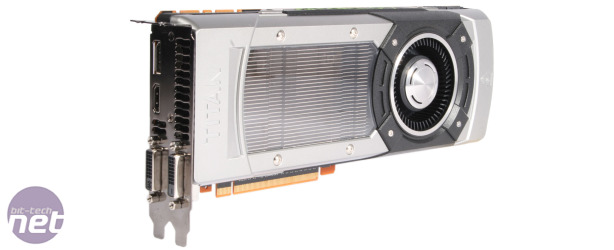Nvidia GeForce GTX Titan First Look
February 19, 2013 | 13:57
Companies: #nvidia-geforce-gtx-titan-first-look #titan

GK110 - Architecture Analysis Continued
GK110 offers other advantages over GK104, although they’re not to the same order of magnitude as the stream processor increase. The 32 ROPs of the GTX 680 2GB has risen 50 per cent to 48 ROPs on GTX Titan, but it’s the memory controller and memory interface where the biggest changes will be felt. GTX 680 2GB was widely criticised for its limited 256-bit memory interface in comparison to the HD 7970’s 384-bit, a shortcoming that GTX Titan re-dresses with a 384-bit memory interface of its own.Similarly the GTX 680’s 2GB of GDDR5 was seen by some as lacking (although we found no performance difference between 2GB and 4GB versions even at 5,760 x 1,080); the GTX Titan takes no such chances with 6GB (!) of GDDR5 split between its six 64-bit memory controllers. Running at the standard 6GHz shared by many of the 6-series cards, they equates to a 288GB/sec of memory bandwidth, a 50 per cent increase over the GTX 680 2GB and matching that of the HD 7970 3GB.
With a huge increase in stream processor count and memory, you’d be forgiven for expecting a similar increase in clock speeds, but the Titan’s stock frequencies are surprisingly restrained for card set to cost upwards of £800. Nvidia’s GPU Boost technology returns in the form of GPU Boost 2.0; this sees a guaranteed base core frequency of 836MHz and a guaranteed boost frequency of 876MHz. This is a much smaller range than that of the GTX 680 2GB, which boosted from 915MHz up to 1,019MHz (and beyond), although the card does typically boost higher under all but the most GPU-melting circumstances. In our labs we've seen our sample typically boosting to 993MHz.

The update version of GPU boost will automatically scale up frequencies based on voltage, temperature and power target
While the guaranteed boost clocks aren’t too far apart, the so-called Boost-curve set by Nvidia has been unlocked to a much greater degree; you can now adjust the temperature target upwards to allow the card to boost to higher frequencies more regularly and the same goes for its power target and core voltage. There’s still a behind-the-scenes algorithm ensuring you don’t melt the card into a crusty pile of circuits and silicon, but some of the much-maligned safety mechanisms in place with the GTX 680 2GB have been removed. The end result is particularly exciting for water-cooling, as Nvidia tells us the card should clock higher the cooler it runs.

MSI MPG Velox 100R Chassis Review
October 14 2021 | 15:04










Want to comment? Please log in.